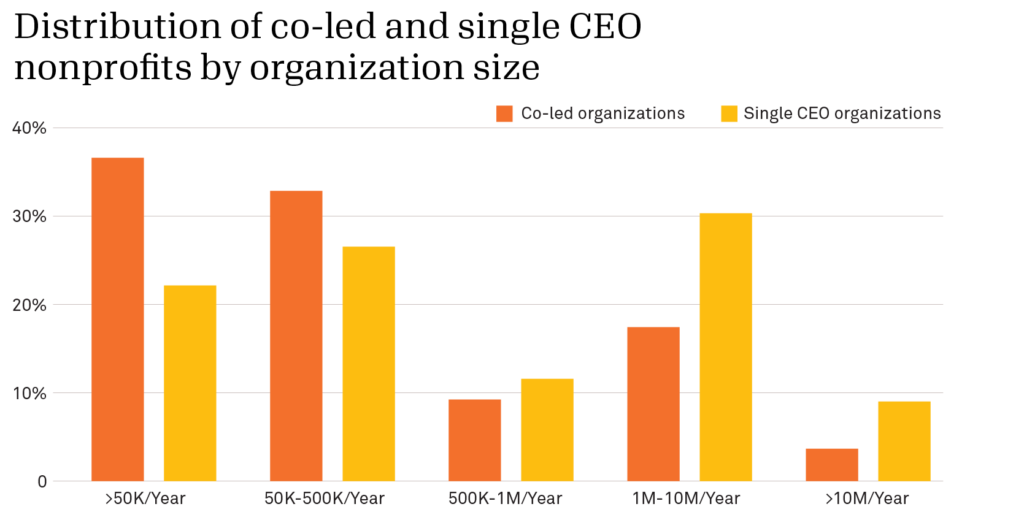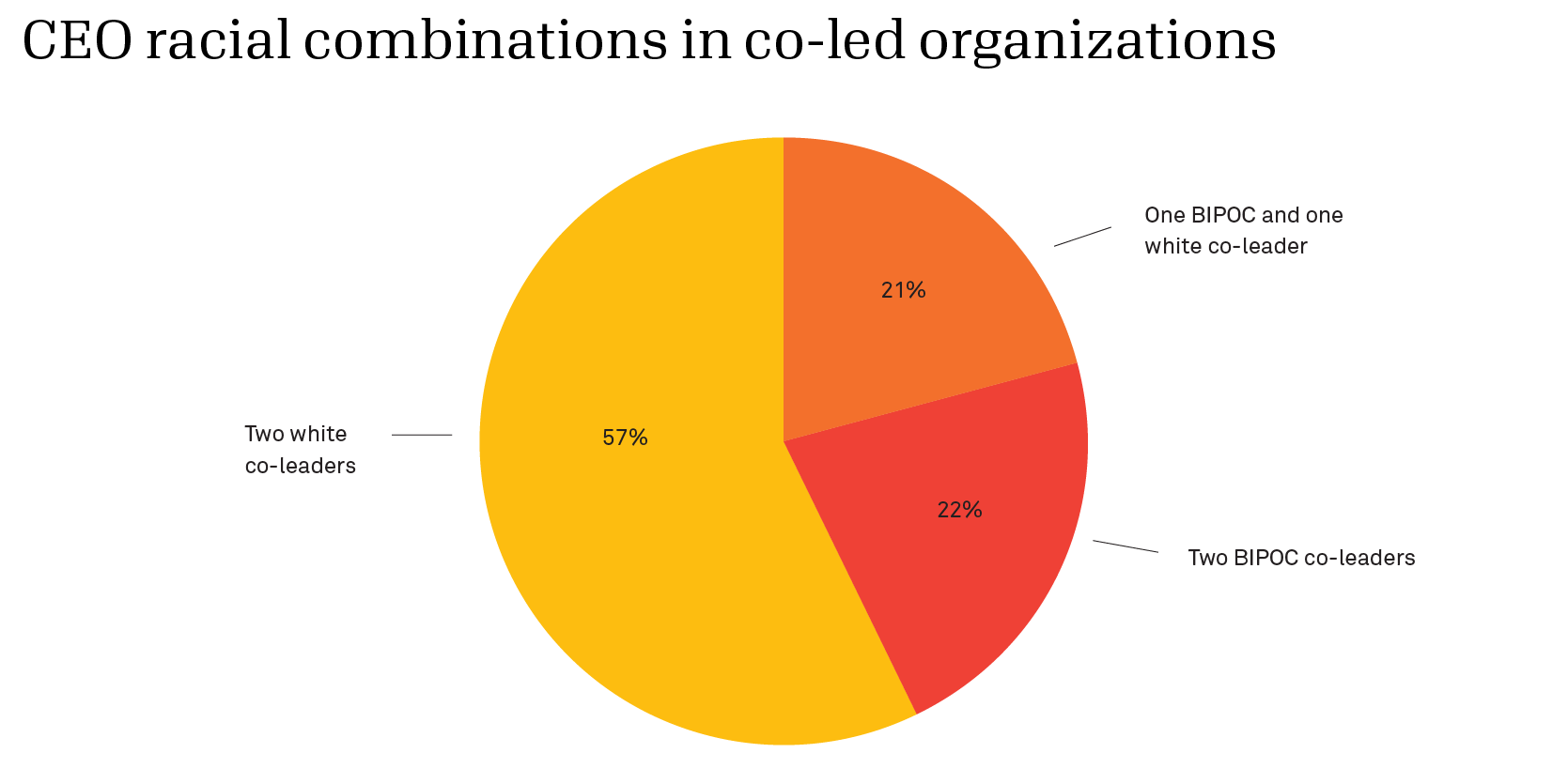Co-leadership: A path to more diverse, sustainable nonprofits?

The concept of co-leadership is not new. But in the wake of the pandemic, the “Great Resignation,” and waves of burnout, more nonprofits may be adopting co-leadership models as they experiment with new ways of working, sharing power, centering BIPOC (Black, Indigenous, and people of color) leaders, and planning for succession. Our analysis of Candid data suggests co-led nonprofits are more common than you might think.
What is co-leadership?
Co-leadership is a leadership structure in which responsibilities are intentionally shared among more than one CEO or executive director. There are many different ways to accomplish this. For example, one co-executive director might focus on internal operations while the other focuses on engaging with funders and constituents. Or in an arts organization, one might focus on artistic direction, the other on the business model.
Some organizations have shifted to a co-leadership model to increase capacity, efficiency, and transparency in their operations. Others have done so to allow for a broader range of identities—both to better reflect the diverse populations they serve and as a way to include more BIPOC leaders. Many also see the model as an approach to dividing leadership duties to reduce burnout, build equity, and support working families.
Nearly a fifth of nonprofits, mostly small, are co-led
Nonprofits sharing demographic information with Candid can select up to two individuals as their organizational leaders. About 18% of public charities sharing this data on Candid profiles, or 10,654 organizations, provided information about two leaders, indicating that they had a co-leadership model in place.
Our analysis shows that the co-led organizations in this data set tend to be smaller in size, as measured by annual expenses. Overall, 37% of co-led nonprofits had annual budgets under $50,000, while only 4% had budgets above $10 million. By contrast, among organizations with single leaders that have shared demographic data, 22% had budgets below $50,000 and 9% had budgets above $10 million.

Just over half of co-led organizations have two white leaders
In terms of racial representation among organizations that listed two executive directors or CEOs, 57% of the organizations indicated that both identified as white, while 22% indicated that both co-leaders identified as BIPOC. Another 21% reported one BIPOC and one white co-leader.

Note: Percentages exclude the 1,040 nonprofits who did not share racial information for one or more of their co-leaders (e.g., indicated that co-leader race was unknown or marked “decline to state”).
By comparison, Candid data suggests that 70% of single-led nonprofits have white executive directors or CEOs. With at least 43% of co-led organizations reporting one or more BIPOC co-leaders, there appears to be more racial diversity at the top of co-led nonprofits.
Leaders of co-led nonprofits are more gender diverse
In terms of gender, the most common composition among co-led nonprofits in this data set, at 45%, was a combination of one co-leader who identifies as male and one who identifies as female. About a third, or 36%, indicated that both of their co-leaders were women, while 19% stated that both of their co-leaders were men.
Put another way, 81% of co-led nonprofits are led by at least one woman and 64% are led by at least one man. By comparison, 63% of single-leader organizations in Candid data have women leaders.

Note: Percentages exclude 538 organizations that did not provide gender information for one or more of their co-leaders (e.g., indicated that gender was unknown or marked “decline to state”) or indicated that one or more co-leaders were nonbinary.
Most co-led nonprofits have no LGBTQIA+ co-leader or co-leader with a disability
Of the nonprofits that shared information about both co-leaders’ sexual orientation, 87% reported no LGBTQIA+ co-leader, while 8% had one LGBTQIA+ co-leader and 5% had two. (Percentages exclude 3,737 organizations that did not provide sexual orientation information for one or more of their co-leaders—for example, indicated that sexual orientation was unknown or marked “decline to state.”) Among single-CEO led nonprofits, 9% had a CEO from the LGBTQIA+ community.
Similarly, 83% of co-led organizations in the data set said neither of their two co-leaders had a disability, while 13% reported one co-leader with a disability and one without and 4% reported that both had a disability. (Percentages exclude 3,496 organizations that did not provide information for one or more of their CEOs—for example, indicated that disability status was unknown or marked “decline to state.”) Among single-led organizations, 10% had a CEO with a disability.
Can co-leadership bring about a more equitable sector?
The fact that co-led nonprofits have more diverse leadership and smaller budgets may not be a coincidence. Candid data shows that Black CEOs, BIPOC women CEOs, and CEOs with a disability are more likely to lead nonprofits with the least financial resources. Candid’s upcoming report, The state of diversity in the nonprofit sector, to be released in a few weeks, will provide a deeper analysis of these patterns.
Another possible reason for greater leadership diversity among co-led nonprofits may be that BIPOC nonprofit leaders report leaving their jobs due to burnout at higher rates than their white counterparts. Therefore, some nonprofits with BIPOC leaders may be shifting to a co-leadership model as a way to address this burnout.
Finally, small community-based organizations may be more likely to see co-leadership as a way to advance their social justice missions by prioritizing power sharing and fostering BIPOC and women’s leadership—starting with their own organizational structures.






Cathleen Clerkin says:
Interesting question, Jodi! Unfortunately, we do not currently have data to answer this question. The data featured in this article comes from the demographic data section of Candid profiles, which tells us about who leads organizations, but doesn’t include information about the hiring process. I think this would make for a great future research project, however. I agree that more information about the dynamics of how co-led structures come to be would be fascinating to unpack.
Eric Braun says:
I'm a BIG fan of Co-Leadership when done with intention. It's an opportunity to have different genders, personalities, backgrounds, skills and/or experiences represented in leadership and to guide the organization or team more effectively. Co-Leadership provides balance and makes tunnel-vision and one-sided views less likely.
Innovation relies on collaboration and diversity. Co-Leadership makes it easier to be innovative.
Jodi Segal says:
Is there any data about the leaders' desire to be in a co-leader relationship? While overall, I think this is a good change, I'm wondering if a reason why those in a co-leadership structure are more likely to be from marginalized communities could be that the Board (falsely) doesn't have confidence in their ability to lead on their own. Conversely, do white leaders with more power refuse this structure, or do their boards not see the need for co-leadership? Either way, I expect that the trend will continue to the benefit of the leaders and their organizations.